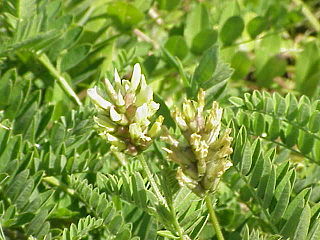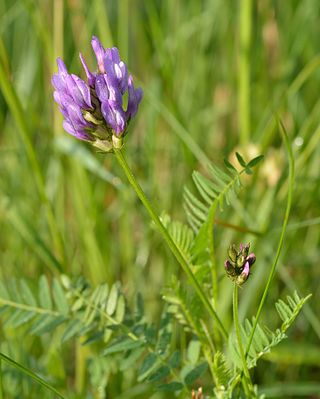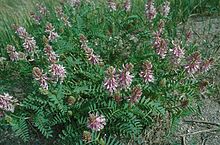Locoweed is a common name in North America for any plant that produces swainsonine, an alkaloid harmful to livestock. Worldwide, swainsonine is produced by a small number of species, most of them in three genera of the flowering plant family Fabaceae: Oxytropis and Astragalus in North America, and Swainsona in Australia. The term locoweed usually refers only to the North American species of Oxytropis and Astragalus, but this article includes the other species as well. Some references may incorrectly list Datura as locoweed.

Astragalus is a large genus of over 3,000 species of herbs and small shrubs, belonging to the legume family Fabaceae and the subfamily Faboideae. It is the largest genus of plants in terms of described species. The genus is native to temperate regions of the Northern Hemisphere. Common names include milkvetch, locoweed and goat's-thorn. Some pale-flowered vetches are similar in appearance, but they are more vine-like than Astragalus.

Solanum americanum, commonly known as American black nightshade, small-flowered nightshade or glossy nightshade, is a herbaceous flowering plant of wide though uncertain native range. The certain native range encompasses the tropics and subtropics of the Americas, Melanesia, New Guinea, and Australia.

Ageratina altissima, also known as white snakeroot, richweed, or white sanicle, is a poisonous perennial herb in the family Asteraceae, native to eastern and central North America. An older binomial name for this species is Eupatorium rugosum, but the genus Eupatorium has undergone taxonomic revision by botanists, and some species once included in it have been moved to other genera.

Astragalus mongholicus, synonyms including Astragalus propinquus and Astragalus membranaceus, commonly known as Mongolian milkvetch in English; 'Хунчир' in Mongolian; huáng qí, běi qí or huáng huā huáng qí, in Mongolia, is a flowering plant in the family Fabaceae. It is one of the 50 fundamental herbs used in traditional Mongolian medicine. It is a perennial plant and it is not listed as being threatened.

Astragalus canadensis is a common and widespread member of the milkvetch genus in the legume family, known commonly as Canadian milkvetch. The plant is found throughout Canada and the United States in many habitats including wetlands, woodlands, and prairies.

Gutierrezia microcephala is a species of flowering plant in the family Asteraceae known by the common names sticky snakeweed, threadleaf snakeweed, threadleaf broomweed, and smallhead snakeweed. It is a subshrub native to the southwestern United States and northern Mexico, and can be found in arid grassland and desert sand dune habitats. It can be toxic to livestock in large quantities, due to the presence of saponins and high concentrations of selenium.

Gutierrezia sarothrae is a species of flowering plant in the family Asteraceae known by the common names broom snakeweed, broomweed, snakeweed, and matchweed. It is a subshrub native to much of the western half of North America, from western Canada to northern Mexico, and can be found in a number of arid, grassland, and mountain habitats. It can be toxic to livestock in large quantities, due mainly to the presence of saponins.
Astragalus bicristatus is a species of milkvetch known by the common names crested milkvetch and two-crested milkvetch. It is endemic to southern California, where it grows in the coniferous forests of the San Gabriel and San Bernardino Mountains of the Transverse Ranges.
Astragalus crotalariae is a species of milkvetch known by the common name Salton milkvetch. It is native to the Colorado Desert in California and other Sonoran Deserts in Arizona and northern Mexico. It grows in desert scrub habitat, including the Salton Sink in the Coachella Valley.

Swainsona greyana, commonly known as the Darling pea or hairy-Darling pea, is a species of flowering plant in the family Fabaceae and is endemic to south-eastern continental Australia. It is an erect perennial subshrub with imparipinnate leaves with 17 to 21 egg-shaped leaflets, and racemes of 12 to 20 or more white, pink or purple flowers.

Astragalus osterhoutii, or the Osterhout milkvetch or Kremmling milkvetch, is an endangered species of milkvetch, discovered and collected in 1905 at Sulfur Spring in Grand County Colorado by Colorado botanist George Everett Osterhout for which the plant was named. It is found in the U.S. state of Colorado, in a 13 kilometres (8.1 mi) radius near the town of Kremmling.

Astragalus cicer, the chickpea milkvetch, chick-pea milk-vetch or cicer milkvetch, is a perennial flowering plant native to Eastern Europe, popularized and subsequently transported to areas in Southern Europe, North America, and South America. It produces pods that resemble those of chickpeas. Its flowers are usually of pale yellow tint, and attract bumble or European honey bees for pollination. Growth often exceeds 0.6 meters, up to a height of 1 meter in length.

Astragalus microcymbus is a species of flowering plant in the legume family known by the common name skiff milkvetch. It is endemic to Colorado in the United States, where it is known from Gunnison County and the edge of Saguache County. It was discovered in 1945 by Rupert Barneby, a British botanist. Currently, skiff milkvetch is experiencing population declines and is listed as a Tier 1 species in the Rare Plant Addendum to the Colorado State Wildlife Action Plan.

Astragalus drummondii is a species of flowering plant in the legume family known by the common name Drummond's milkvetch. The botanist Thomas Drummond first identified the plant during his travels in North America from 1825 to 1835, the year of his death. Astragalus drummondii is one of many plants named after him. Upon the return of samples collected by Drummond to England, his findings were published in Sir William Hooker’s Flora Boreali-Americana in 1840.

Astragalus preussii is an annual or perennial plant in the legume family (Fabaceae) found in the Colorado Plateau and Canyonlands region of the southwestern United States.

Astragalus mollissimus is a perennial plant in the legume family (Fabaceae) found in the Colorado Plateau and Canyonlands region of the southwestern United States.

Astragalus danicus, known as purple milk-vetch, is a species of flowering plant in the family Fabaceae (legumes), which is native to Europe.

Astragalus crassicarpus, known as ground plum or buffalo plum, is a perennial species of flowering plant in the legume family, Fabaceae, native to North America. It was described in 1813. The fruit is edible and was used by Native Americans as food and horse medicine. It is a host of afranius duskywing larvae. It is also known as groundplum milkvetch and pomme de prairie.

Astragalus racemosus, the cream milkvetch, is a species of flowering plant in the family Fabaceae. It is native to central North America. A selenium hyperaccumulator, it is considered capable of poisoning livestock as one of the locoweeds.


















